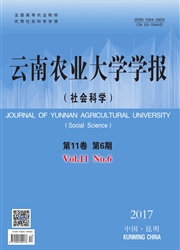

 中文摘要:
中文摘要:
研究了魔芋与玉米间栽对魔芋软腐病的控制作用,同时采用Biolog方法间栽对魔芋根际微生物群落代谢功能多样性的影响。结果表明,魔芋与玉米间栽能有效控制魔芋软腐病,其中玉米2:魔芋4(T3)效果最好,相对防效可达61.27%。另外,魔芋与玉米间栽使魔芋根际微生物Shannon多样性、均匀度指数和每孔颜色平均变化率(AWCD)发生变化,魔芋根际微生物对碳源的利用情况也发生了改变,与净栽魔芋(CK)相比,B对聚合物类和酚类化合物的利用率分别升高了25.7%和23.5%,而对糖类、羧酸类、氨基酸类和胺类这4类碳源的利用率分别降低了30.7%,39.9%,34.9%和38.6%。主成分分析表明,间栽处理的魔芋根际微生物群落代谢功能与净栽相比差异显著。
 英文摘要:
英文摘要:
The experiment was carried out to investigate the effects of konjac and maize intercropping on the soft rot of Amorphophallus Konjac and the metabolic functional diversity of Konjac rhizosphere microbial community by biolog ECO microplates. The results showed that Konjac and maize intercropping could effectively suppress the disease, the T3 treatment (maize 2: Konjac 4) had the highest con- trol efficiency which reached to 61.27%. In addition, Shannon diversity, Shannon evenness and the average well color development (AWCD) were influenced by intercropping; the ability of utilizing carbon source of Konjac rhizosphere microbe varied in different treatments of intercropping, the variation of T3 was significant among all the treatments. Compared with Konjac monoculture (CK), the abilities of utilizing polymers and phenolic compounds of T3 raised 25.7 % and 23.5 %, respectively ; however, the abilities of utilizing .carbohydrates, carboxylic acids, amino acids and amines of T3 reduced 30.7%, 39.9%, 34. 9% and 38.6%, respectively. The results of principal components analysis (PCA) showed an obvious difference of the metabolic functional diversity between intercropping and Konjac monoculture.
 同期刊论文项目
同期刊论文项目
 同项目期刊论文
同项目期刊论文
 期刊信息
期刊信息
